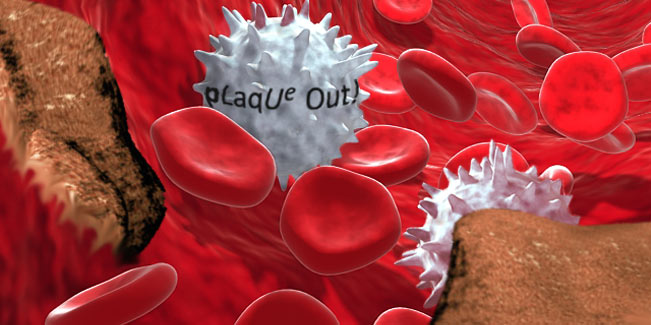Team:NTU-Singapore/Project
From 2009.igem.org
pLaqUe Out!
The NTU iGEM '09 Team has identified atherosclerosis as the problem we would like to tackle.
We propose to use a biological system that identifies and degrades atherosclerotic plaque in vivo.
Background
Atherosclerosis is one of the major diseases affecting the world. In our research, up to 7.2 million people are affected by coronary artery disease alone; a majority of these are caused by atherosclerosis [1]. In most cases, diagnosis is rare, medications are not ideal and surgeries are a commonly used last resort.
Atherosclerosis is an inflammatory disease caused by the buildup and hardening of fatty deposits on arterial walls. This accumulation eventually restricts the blood flow through the affected vessels [2]. Here's an [http://www.youtube.com/watch?v=fLonh7ZesKs informative video] describing the nature of atherosclerotic buildup, and the deadly consequences.
In our research and literature review, we identified the following characteristics of plaque buildup.
- Intuitively, we understand that decreased lumen area due to plaque leads to faster flow rate of blood.
- Research shows that damaged arterial endothelium exhibits a surface protein, p-selectin, abundantly at the lumen surface to signal for help [3].
- This p-selectin binds selectively to the ligand, p-selectin glycoprotein (PSGL-1), via natural catch-bond mechanism, which works best in fast-flowing conditions [4].
- Research indicates that damage to arterial endothelial cells leads to decreased local levels of nitric oxide (NO) in blood [5].
- On a tangential note, NO is also a known vasodilator.
- We find that the lipid core in foam cells are in the form of cholesteryl esters [6].
- The body is not able to break down such oxidized cholesterols. [7]
- Diagnosis of plaque is usually done in late-stage due to delayed symptoms [8].
Inadequacy of current treatments
Atherosclerotic plaque buildup is a gradual process. It does not help that the body accommodates for any changes, hence delaying the onset of symptoms until it's too late. Symptoms themselves vary depending on which arteries exactly the plaque buildup develop [2,8].
As such, present medications are catered largely toward immediate relief of symptoms, and less on reversing the condition. Unfortunately, the medication is also accompanied by the need for a complete lifestyle change to prevent the problem from getting worse. More often that we would prefer, major surgeries, like bypass surgery (including open-heart surgery) & stent placement, become necessary. These surgeries are followed by long recovery periods, which may be devastating to patients.
Engineering a solution
Our proposed biological system seeks to overcome the shortcomings of present approaches, by being less intrusive & more efficient. We propose the following as conditions our system must fulfill:
- Our system must sense changes in blood [NO].
- If it falls below healthy physiological levels, then the system is triggered to switch on.
- Additionally, our system will be specific to plaque sites due to p-selectin biomarkers.
- The system must release an enzyme to breakdown the cholesteryl esters in plaque.
- The system must release a reporter protein that allows for for in vivo visualization and monitoring of the plaque site.
- The system must re-generate [NO] at the plaque site.
- Not only does this dilate the vessel, it also serves as feedback to shut down the system.
Our ideal system will be based in a mammalian blood cell; ideally a T-helper cell could be used. The advantage of using a T-helper cell is that expression/exhibition of PSGL-1 at the surface becomes trivial [3].
References/Literature
- WHO Medical Centre (2009). "Cardiovascular diseases (CVDs)." from http://www.who.int/mediacentre/factsheets/fs317/en/index.html.
- MayoClinic.com. (2008). "Definition of Arterioscleriosis." from http://www.mayoclinic.com/health/arteriosclerosis-atherosclerosis/DS00525.
- Eric Borges, W. T., Martin Steegmaier,* Thomas Moll,* Rupert Hallmann,§ Alf Hamann, and Dietmar Vestweber* (1997). "P-Selectin Glycoprotein Ligand-1 (PSGL-1) on T Helper 1 but Not on T Helper 2 Cells Binds to P-Selectin and Supports Migration into Inflamed Skin" Journal of Experimental Medicine 185.
- W. Thomas, “Catch Bonds in Adhesion” Annu. Rev. Biomed. Eng., vol 10, 39-57, 2008.
- Ferenc I. Tarr MD, P., Mária Sasvári MDb, Márton Tarr MD and Rozália Rácz MD (2005). "Evidence of Nitric Oxide Produced by the Internal Mammary Artery Graft in Venous Drainage of the Recipient Coronary Artery." The Annals of Thoracic Surgery 80(5): 1728-1731.
- G. K. Hansson, Anna-Karin L. Robertson, C. Soderberg-Naucler, “Inflammation and Atherosclerosis” Annu. Rev. Pathol. Mech. Dis., vol 1, 297-329, 2006.
- Moniek N. Pieters, Sebastiaan Esbach, Donald Schouten, Adriaan Brouwer, Dick L. Knook, Theo J. C. Van Berkel, "Cholesteryl esters from oxidized low-density lipoproteins are in vivo rapidly hydrolyzed in rat kupffer cells and transported to liver parenchymal cells and bile", Hepatology Vol 19, Issue 6 , Pages 1459 - 1467
- NIH. "How is Atherosclerosis Diagnosed?", from http://www.nhlbi.nih.gov/health/dci/Diseases/Atherosclerosis/Atherosclerosis_Diagnosis.html.
- E. Galkina, K. Ley, “Immune and Inflammatory Mechanisms of Atherosclerosis” Annu. Rev. Immunol., vol 27, 165-97, 2009.
- Anderson, T. J. M. (2003). "Nitric Oxide, Atherosclerosis and clinical relevance of endothelial dysfunction." Heart Failure Reviews 8: 71 - 86.
See the complete list of references here.
 "
"
